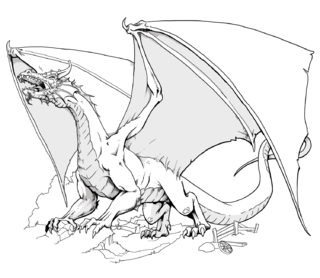
In the Dungeons & Dragons (D&D) fantasy role-playing game, dragons are an iconic type of monstrous creature. As a group, D&D dragons are loosely based on dragons from a wide range of fictional and mythological sources. Dungeons & Dragons allows players to fight the fictional dragons in the game and "slay their psychic dragons" as well. These dragons, specifically their "dungeon ecology", have implications for the literary theory of fantasy writing. D&D dragons also featured as targets of the moral panic surrounding the game.
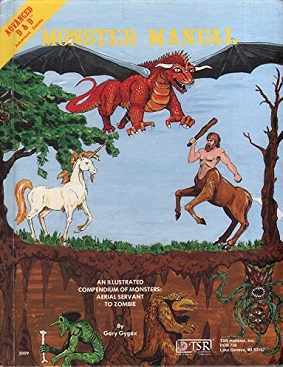
The Monster Manual is the primary bestiary sourcebook for monsters in the Dungeons & Dragons fantasy role-playing game, first published in 1977 by TSR. The Monster Manual was the first hardcover D&D book and includes monsters derived from mythology and folklore, as well as creatures created specifically for D&D. Creature descriptions include game-specific statistics, a brief description of its habits and habitats, and typically an image of the creature. Along with the Player's Handbook and Dungeon Master's Guide, the Monster Manual is one of the three "core rulebooks" in most editions of the D&D game. As such, new editions of the Monster Manual have been released for each edition of D&D. Due to the level of detail and illustration included in the 1977 release, the book was cited as a pivotal example of a new style of wargame books. Future editions would draw on various sources and act as a compendium of published monsters.

Monster Manual II is the title shared by two hardback rulebooks published for different versions of the Dungeons & Dragons (D&D) fantasy roleplaying game.
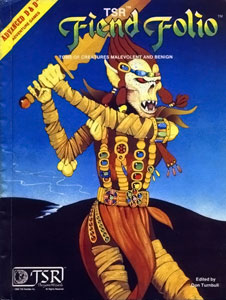
Fiend Folio is the name of three separate products published for successive editions of the fantasy role-playing game Dungeons & Dragons (D&D). All three are collections of monsters.
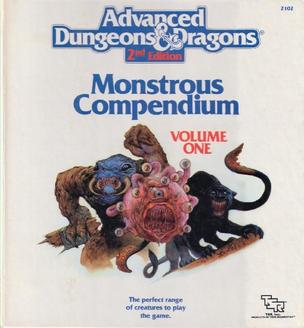
The Monstrous Compendium is a series of accessories for the Advanced Dungeons & Dragons fantasy role-playing game released from 1989 to 1998. The title was then used for a series of 5th Edition Dungeons & Dragons supplements released on D&D Beyond.

The Dungeon Master's Guide is a book of rules for the fantasy role-playing game Dungeons & Dragons. The Dungeon Master's Guide contains rules concerning the arbitration and administration of a game, and is intended for use by the game's Dungeon Master.

An owlbear is a fictional creature originally created for the Dungeons & Dragons fantasy role-playing game. An owlbear is depicted as a cross between a bear and an owl, which "hugs" like a bear and attacks with its beak. Inspired by a plastic toy made in Hong Kong, Gary Gygax created the owlbear and introduced the creature to the game in the 1975 Greyhawk supplement; the creature has since appeared in every subsequent edition of the game. Owlbears, or similar beasts, also appear in several other fantasy role-playing games, video games and other media.

In the Dungeons & Dragons fantasy role-playing game, the mimic is a type of fictional monster. It is portrayed as being able to change its shape to disguise its body as an inanimate object, commonly a chest. The mimic uses a powerful adhesive that holds fast to creatures that touch it, allowing the mimic to beat its victims with its powerful pseudopods. The mimic was introduced in the first edition Advanced Dungeons & Dragons game's original Monster Manual. The mimic has appeared in subsequent editions. Several variants of the creature have been introduced, with a variety of abilities and sizes.

Tiamat is a supremely strong and powerful 5-headed draconic goddess in the Dungeons & Dragons role-playing game. The name is taken from Tiamat, a goddess in ancient Mesopotamian mythology. She is the queen and mother of evil dragons and a member of the default pantheon of Dungeons & Dragons gods. Her symbol is a five-headed dragon.

Creature Catalogue is a supplement for Basic Dungeons & Dragons first released in 1986, and updated in 1993.

In the Dungeons & Dragons (D&D) role-playing game, Bahamut is a powerful draconic deity, who has the same name as Bahamut from Arabic mythology.
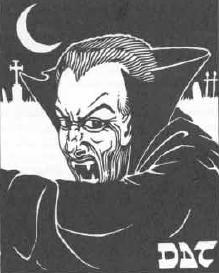
In the Dungeons & Dragons fantasy role-playing game, a vampire is an undead creature. A humanoid or monstrous humanoid creature can become a vampire, and looks as it did in life, with pale skin, haunting red eyes, and a feral cast to its features. A new vampire is created when another vampire drains the life out of a living creature. Its depiction is related to those in the 1930s and 1940s Hollywood Dracula and monster movies. In writing vampires into the game, as with other creatures arising in folklore, the authors had to consider what elements arising in more recent popular culture should be incorporated into their description and characteristics.

Monster Manual V is an optional supplemental source book for the 3.5 edition of the Dungeons & Dragons role-playing game.
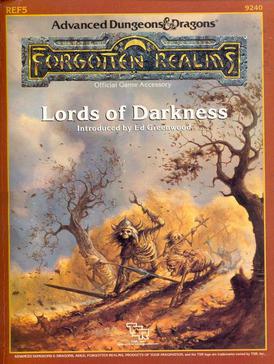
Lords of Darkness is the name of two accessories for the fictional Forgotten Realms campaign setting for the Dungeons & Dragons fantasy role-playing game.
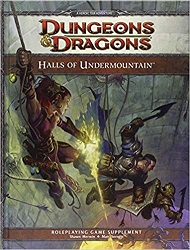
Halls of Undermountain is an adventure for the 4th edition of the Dungeons & Dragons role-playing game.

In the Dungeons & Dragons fantasy role-playing game, the term "monster" refers to a variety of creatures, some adapted from folk myths and legends and others invented specifically for the game. Included are traditional monsters such as dragons, supernatural creatures such as ghosts, and mundane or fantastic animals. Monsters are typically used as obstacles which the players must overcome to progress through the game. Beginning with the first edition in 1974, a bestiary was included along other game manuals, first called Monsters & Treasure and now commonly known as the Monster Manual. As an essential part of Dungeons & Dragons, many of the game's monsters have become iconic in their own right, becoming influential in video games, fiction, and popular culture.

Volo's Guide to Monsters is a sourcebook for the 5th edition of the Dungeons & Dragons fantasy role-playing game, published in 2016. It is, in part, a supplement to the 5th edition Monster Manual and the Players Handbook.

Uncaged is an adventure anthology series for the 5th edition of the Dungeons & Dragons fantasy role-playing game. Each volume contains various adventures which feature the subversion of classic female mythological creature and monster tropes. The project was created by Ashley Warren and features the work of over 100 writers, illustrators, and editors.














